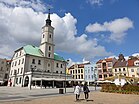Metropolis GZM[1]
Metropolia GZM Górnośląsko-Zagłębiowska Metropolia[2] | |
|---|---|
Metropolis | |
| |
 Location on the map of Poland | |
| Country | Poland |
| Voivodship | Silesia |
| Council | Zarząd GZM |
| Government | |
| • Head of Council | Kazimierz Karolczak |
| Area | |
• Total | 2,554 km2 (986 sq mi) |
| Population (2022)[3] | |
• Total | 2,142,800 |
| • Density | 840/km2 (2,200/sq mi) |
| GDP | |
| • Total | €44.570 billion (2021) |
| • Per capita | €20,800 (2021) |
| Time zone | UTC+01:00 (CET) |
| • Summer (DST) | UTC+02:00 (CEST) |
| Area code | +48 32 |
| Website | metropoliagzm |
The Metropolis GZM[1] (Polish: Metropolia GZM, formally in Polish Górnośląsko-Zagłębiowska Metropolia)[2] is a metropolitan association composed of 41 contiguous municipalities in the Silesian Voivodeship of Poland. The seat of the metropolitan council is Katowice, the largest member city and the voivodeship capital. With a population of over 2 million, the core of the Metropolis GZM is one of the largest urban areas in the European Union. The area of the metropolis largely coincides with the metropolitan area of the Katowice urban area, which is a part of the wider cross-border Katowice-Ostrava metropolitan area, the latter with a population of 5–5.3 million people.[5][6]
Metropolis GZM was created in June 2017 act of Parliament, with its boundaries defined by a regulation of Poland's Council of Ministers which expanded the earlier existing Upper Silesia Metropolitan Union (Polish: Górnośląski Związek Metropolitalny). That original union was formed ten year earlier in Świętochłowice by 14 core cities.[7][8] The purpose of the metropolis is to maintain a strong urban and industrially developed area with internationally competitive profile and unified management of all infrastructure.[9][10] For these tasks, the metropolis receives 5% of the income tax of its residents and participating municipalities.
- ^ a b "Metropolia dziś / Metropolis today - Metropolia GZM". Retrieved 31 March 2021.
- ^ a b Council of Ministers (25 June 2017). "Full text of the Government bill establishing the Górnośląsko-Zagłębiowska Metropolia" [Utworzenie przez Rade Ministrów związku metropolitalnego pod nazwą „Górnośląsko-Zagłębiowska Metropolia”. Rozporządzenie] (PDF).
{{cite journal}}: Cite journal requires|journal=(help) - ^ "Stan ludności - InfoGZM". infogzm.metropoliagzm.pl. Retrieved 23 April 2024.
- ^ "Gross domestic product (GDP) at current market prices by metropolitan regions". www.ec.europa.eu. Retrieved 12 December 2023.
- ^ "Redefining Global Cities". Brookings Institution. 30 November 2001.
- ^ "Study on Urban Functions (Project 1.4.3)" Archived 24 September 2015 at the Wayback Machine – European Observation Network for Territorial Development and Cohesion, 2007
- ^ Uchwały Rady Miejskiej w Świętochłowicach w 2006 roku (en: Resolutions of the City Council in Świętochłowice in 2006), Świętochłowice 2006
- ^ (in Polish) www.esil.pl - "Rejestracja Górnośląskiego Związku Metropolitalnego", 27 June 2007
- ^ "Dz.U. 2017 poz. 730: Ustawa z dnia 9 marca 2017 r. o związku metropolitalnym w województwie śląskim". Dziennik Ustaw (2017 Poz. 730) (in Polish).
- ^ Prezes Rady Ministrów: B. Szydło (1 July 2017), Utworzenie w województwie śląskim związku metropolitalnego pod nazwą „Górnośląsko-Zagłębiowska Metropolia”.





